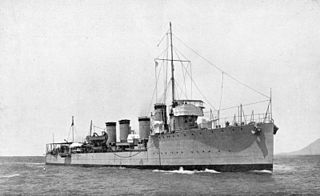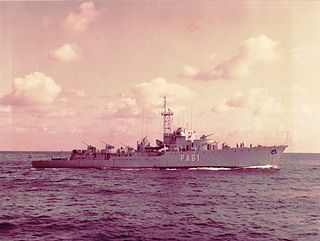
HSwMS Sjölejonet was the lead ship of a class of nine naval submarines in the service of the Swedish Navy from just before World War II into the early Cold War. The submarines were ordered in response to the rising German threat to the south in the interwar period. Sjölejonet remained in service until 1959 and was sold for scrap in 1962.

HMS Brighton was a Rothesay or Type 12I class anti-submarine frigate of the Royal Navy.

The Commandant Rivière class was a class of frigates built for the French Navy in the late 1950s and early 1960s. Labeled "aviso-escorteur", they were designed to perform the role of overseas patrol in peacetime and anti-submarine escort in wartime. This vessel class is named after the French Navy officer Henri Rivière (1827–1883).

The Mendoza class were a series of three destroyers built in the United Kingdom for the Argentine Navy in the 1920s. They were the first part of the Argentine re-armament programme of the 1920s. Construction began in 1927 and all three were commissioned in 1929. All three destroyers were converted to anti-aircraft escorts in 1958 and remained in service until 1962 when they were discarded.

BAP Abtao (SS-42) is an Abtao-class submarine of the Peruvian Navy. The vessel which was originally named BAP Tiburón ("Shark"), was constructed by the American Electric Boat company in the United States and launched in 1953. The Abtao class were the last submarines constructed by the United States for the export market. The submarine entered service in 1954 and by presidential decree, was renamed Abtao for the battle during the Chincha Islands War.
The Abtao class were four submarines of the Peruvian Navy that entered service between 1954 and 1957. They are also known as the Lobo class and the Dos de Mayo class and were constructed in the United States to a design based upon the United States Navy's Mackerel class. They were the last submarines to be constructed by the United States for the export market. All four submarines were powered by a diesel-electric system and armed with six 21-inch (533 mm) torpedo tubes. Two of the submarines also mounted a 5 in (127 mm)/25 caliber gun. The four submarines, initially named for animals, were all renamed in 1957 for famous Peruvian battles. Beginning in 1991, the submarines were taken out of service, with the last decommissioned in 1999. One, BAP Abtao, is a museum ship located in Lima, Peru.

NRP Gonçalo Velho was a second class Gonçalo Velho-class sloop of the Portuguese Navy. She was designed to operate in the overseas territories of Portugal. The ship entered service in 1933 and was among the core of the fleet until the late 1940s. Following World War II, new ships were acquired and Gonçalo Velho was broken up for scrap in 1961.

NRP Gonçalves Zarco was a second class Gonçalo Velho-class sloop of the Portuguese Navy. She was designed to operate in the overseas territories of Portugal. The ship entered service in 1933 and was among the core of the fleet until the late 1940s. Following World War II, new ships were acquired and Gonçalves Zarco was discarded 1969.

The Dealey-class destroyer escorts were the first post-World War II escort ships built for the United States Navy.

The Bergamini class was a class of four frigates operated by the Italian Navy. They entered service in 1961, with the last one being stricken in 1988.

The Alsedo class was a Spanish class of destroyer. Three ships were built, based on a British design, entering service between 1924 and 1925. They all served through and survived the Spanish Civil War, two on the Republican side and one with the Nationalists. The class was retired in 1957–1961.

The Albatros class was a class of eight corvettes designed and built in Italy in the 1950s. Paid for by US funds, they were operated by Italy, Denmark, Indonesia and the Netherlands. The last ships of the class were retired from service in Italy in 1991.

The Admiral Pereira da Silva class of frigates, also known as Admiral-class frigates, were in the service of the Portuguese Navy between 1966 and 1985. The class was based on the Dealey-class destroyer escort of the United States Navy. The three ships of the class were built in Portugal, at the Lisnave shipyards and the shipyards of Viana do Castelo. The construction of the ships was part of the effort of Portugal to expand its fleet in the face of unrest in the empire and was financed by the United States via the Mutual Defense Assistance Program. Financial problems prevented them from ever being modernised and they were deleted in 1989.

The EDIC or Engin de débarquement d'infanterie et de chars are large landing craft that operate in the French Navy, Lebanese Navy, Senegalese Navy, and Madagascar Navy. EDICs have the typical landing craft utility design with a bow ramp and have a large aft superstructure compared to the derivative CDIC. The EDIC vessels were constructed in three groups, the first were launched in 1958, the second in 1967–1969 and the third in 1987. A sub class, called the Engin de débarquement ateliers or EDA was constructed between the first and second groups but were fitted out as repair craft. In French service, they predominantly were used in the French Pacific territories.
INS Brahmaputra (F31) was a Leopard-class frigate of the Indian Navy. She was built by the Scottish shipbuilder John Brown & Company and completed in March 1958. Brahmaputra served during the Indo-Pakistani War of 1965 and the Indo-Pakistani War of 1971. She was scrapped in 1986.

The Audaz class was a class of nine destroyers built for the Spanish Navy after the Second World War. Construction was slow, with only four completed to the original design from 1953–1956. The remaining five ships completed as anti-submarine escorts with a new armament and sensor fit from 1960 to 1965, while the original four ships were also modified to this standard. Built at Ferrol, they completed in 1946–1950 and were rated as gunboats, and were redesignated as frigates in 1959. The last of the class, Intrepido, was stricken in 1982.
The Pizzaro class was a class of eight escort vessels built for the Spanish Navy in the 1940s. Built at Ferrol, they were completed in 1946–1950 rated as gunboats, and were redesignated as frigates in 1959. They started to be withdrawn from use in 1968, with the last of the class, Vincente Yañez Pinzon, stricken in 1982.

The Atrevida class was a class of six corvettes built for the Spanish Navy in the 1950s.

KRI Oswald Siahaan (354) is an Ahmad Yani-class frigate operated by the Indonesian Navy. Prior to her service in the Indonesian Navy, she served in the Royal Netherlands Navy as Van Speijk-class frigateHNLMS Van Nes (F805).
Ariete was a Spanish Audaz-class destroyer. Ariete was launched in 1955 and completed in 1961. The ship was lost when she ran aground on 25 February 1966.















